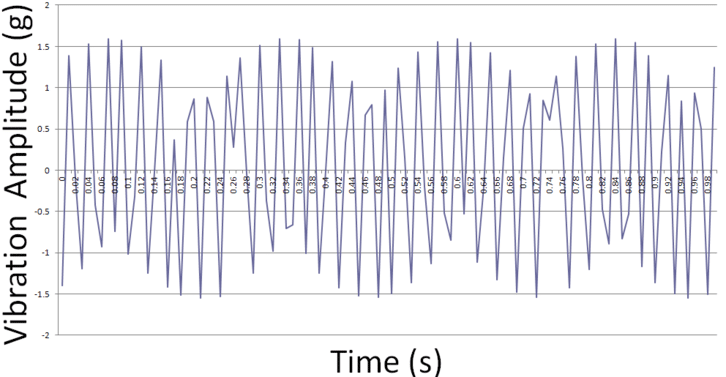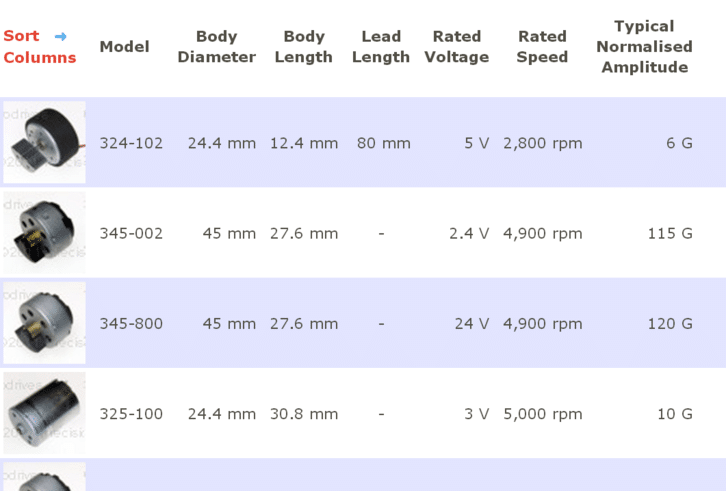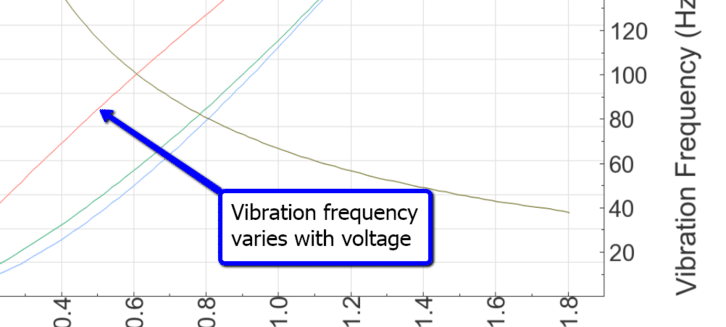The Limits of Vibration Frequency for Miniature Vibration Motors
Introduction
There are lots of interesting applications that require a specific vibration frequency. An exact frequency may be needed for different reasons, often it’s either a particular aspect of academic research or related to work with humans and the nervous system/skin.
As a result, we are sometimes asked if we can supply a vibration motor that operates at a certain frequency or within a band of frequencies – e.g. 100 – 200 Hz.
The majority of the time the answer is yes, but there are some limiting factors. First, it is best to explain that the vibration frequency is directly related to the speed of the motor:
$$f_{vibration} (Hz) = \frac{MotorSpeed\: (RPM)}{60}$$
So for a motor to vibrate at 100 Hz, it would need to have a speed of 6,000 RPM. We can also see that the vibration frequency is not directly dependent upon any other factors of the motor, e.g. size, voltage, etc.
Also, the speed of a DC motor (and therefore the vibration frequency of an ERM) is dependant upon the applied voltage. Therefore you can easily adjust the vibration frequency by adjusting the input voltage.
However, there are a few limits and caveats with varying the frequency.
1. Upper-Frequency Limit
The rotation of the motor shaft is created by passing a current through the wire in a magnetic field, which creates a force. The small size of the motor limits the magnetic field, and therefore the force. Also, there is little use for miniature vibration motors above 24 V and most are around the 1.5 – 3 V range – so the current is also limited. You can also see problems from overheating when operating with excessive currents.
This means that the motors have an upper speed limit. Our fastest vibration motor is the 312-401 at 17,000 RPM (~283 Hz).
2. Lower Frequency Limit
The vibration strength of the motor is governed by this equation:
$$F_{0} = m \times r \times \omega^{2}$$
Where \(m\) is the mass of the eccentric weight, \(r\) is the eccentricity of the weight, and \( \omega \) is the angular velocity (speed) of the motor.
With miniature motors both \( m \) and \( r \) are extremely small, so to ensure they generate enough vibration strength to be of use – they compensate by increasing the speed \( \omega \).
Our slowest vibration motor is the 324-102 rated at 2,800 RPM (~47 Hz). See the tips at the bottom to help with achieving lower frequencies.
3. Varying Vibration Frequency = Varying Vibration Amplitude
As you can see from the equations mentioned above, both the vibration frequency and the vibration amplitude are dependant upon the speed of the motor. This means you cannot adjust one without affecting the other.
Linear Resonant Actuators separate the frequency and amplitude so that the voltage only changes the vibration strength. However, they only operate at a fixed resonant frequency.
4. Getting the Exact Frequency
The tiniest of variances in manufacturing can lead to differences between motors of the same model, and even the same batch. So many of the specifications have a tolerance.
In our product datasheets (available for download on the product pages) we offer more details about the motor. In here you can see that there is a tolerance on the Rated Speed of the motor.
The 303-100 (our second fastest) has a tolerance of +/- 3,200 RPM. So two motors of the same batch could pass testing, but at their rated voltage have a difference of 6,400 RPM in speed. That’s equivalent to ~107 Hz. To be sure you have the right frequency you will need to measure it (use an accelerometer or a crude homemade alternative).
Tips for Finding an Appropriate Motor
Remember \( f_{vibration} (Hz) = \frac{MotorSpeed\: (RPM)}{60} \).
Now using this link:
Filter Precision Microdrives Vibration Motors by Features – update April 2016: unfortunately, this feature has been depreciated from our product catalogue. The content is kept for historical purposes as it still shows the principle for deducing a vibration frequency from motor speed, but searching the catalogue must be done manually until we reinstate this feature.
You can organise our products by a range of specifications by opening/closing the boxes on the left, and opening the Rated Speed box. Now the Rated Speed has appeared in the table columns, click the heading to sort the vibration motors by speed.

Remember the Rated Speed is measured at the Rated Voltage, you can easily decrease the speed by decreasing the input voltage. However, it is much more difficult (and bad for the motor) to go above the Rated Voltage. So pick a motor that goes above or close to your desired frequency.
As a final check, you can use the Typical Performance Characteristics Graph to see the range of frequencies the vibration motor operates.



Get in touch
Speak to a member of our team.
Motor catalogue
Looking for our products?
Reliable, cost-effective miniature mechanisms and motors that meet your application demands.
Discover more
Resources and guides
Discover our product application notes, design guides, news and case studies.
Case studies
Explore our collection of case studies, examples of our products in a range of applications.
Precision Microdrives
Whether you need a motor component, or a fully validated and tested complex mechanism – we’re here to help. Find out more about our company.